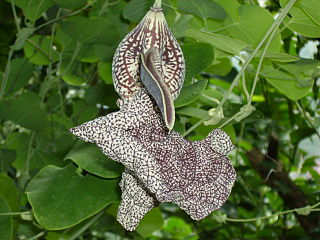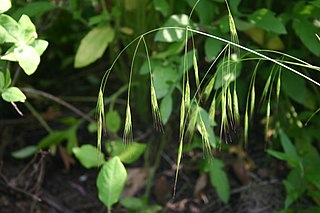
Yunnan is an inland province in Southwestern China. The province spans approximately 394,000 km2 (152,000 sq mi) and has a population of 47.2 million. The capital of the province is Kunming. The province borders the Chinese provinces of Guizhou, Sichuan, autonomous regions of Guangxi and Tibet, as well as Southeast Asian countries Myanmar (Burma), Vietnam, and Laos. Yunnan is China's fourth least developed province based on disposable income per capita in 2014.

Hornbeams are hardwood trees in the plant genus Carpinus in the family Betulaceae. Its species occur across much of the temperate regions of the Northern Hemisphere.

The Aristolochiaceae are a family, the birthwort family, of flowering plants with seven genera and about 400 known species belonging to the order Piperales. The type genus is Aristolochia L.

Aristolochia is a large plant genus with over 500 species that is the type genus of the family Aristolochiaceae. Its members are commonly known as birthwort, pipevine or Dutchman's pipe and are widespread and occur in the most diverse climates. Some species, like A. utriformis and A. westlandii, are threatened with extinction.

Illicium is a genus of flowering plants treated as part of the family Schisandraceae, or alternately as the sole genus of the Illiciaceae. It has a disjunct distribution, with most species native to eastern Asia and several in parts of North America, including the southeastern United States, Mexico, and the Caribbean. General common names include star anise and anisetree. The genus name comes from the Latin illicere.

Daphniphyllum is the sole genus in the flowering plant family Daphniphyllaceae and was described as a genus in 1826. The genus includes evergreen shrubs and trees mainly native to east and southeast Asia, but also found in the Indian Subcontinent and New Guinea.
Hemipilia simplex is a species of plant in the family Orchidaceae. It is endemic to China, where it is found in Sichuan and Yunnan. Its flowers are yellow, sometimes with brown spots.
Hemipilia tetraloba is a species of plant in the family Orchidaceae. It is endemic to China where it is known from Sichuan and Yunnan. The flowers are pink or pale purple.
Aristolochia cucurbitoides is a species of plant in the family Aristolochiaceae. It is endemic to China.
Aristolochia thwaitesii, also known as hai bian ma dou ling, is a species of plant in the family Aristolochiaceae. It is endemic to China.
Aristolochia utriformis is a species of plant in the family Aristolochiaceae. It is endemic to China. It is found in forests at about 1900 meters in Yunnan Province. The plants are climbing herbs or shrubs that have pointed leaves with heart shaped bases. The yellow-green flowers are tube shaped and bent. They hang from the base of a leaf.

Aristolochia westlandii is a species of plant in the family Aristolochiaceae. It is found in China and Hong Kong, in valley forests in Guangdong Province at an elevation of 300 to 800 metres. The leaves are long, narrow and pointed. The flowers are bent tubes from 10–15 centimetres (3.9–5.9 in) long that grow from the base of a leaf. They are yellow with purple veins and blotches.
Hemipilia hemipilioides is a species of orchid endemic to China, where it is found in Yunnan and Guizhou. It produces pinkish flowers with purplish spots.
Hemipilia yueana is a species of plant in the family Orchidaceae. It is endemic to China, where it is known from Sichuan and Yunnan. It produces pink or white flowers. The epithet is also spelt "yuana".

Schizachne is a genus of Eurasian and North American plants in the grass family. The only accepted species is Schizachne purpurascens, commonly called false melic. Three subspecies are recognized:
Hypericum acmosepalum is a dwarf shrub in Hypericumsect. Ascyreia that is native to China and known as jian e jin si tao locally.

Camellia taliensis is a small species of evergreen shrub whose leaves and leaf buds are used to produce tea.

Hypericum lancasteri, known as Lancaster's St. John's wort or as zhan e jin si tao in Chinese, is a species of flowering plant in the St. John's wort family Hypericaceae. The species has been awarded the Royal Horticultural Society's Award of Garden Merit.

Aristolochia paucinervis is a herbaceous plant in the family Aristolochiaceae endemic to the western Mediterranean Basin.

Aristolochia argentina is a herbaceous plant in the family Aristolochiaceae. It is native to northern Argentina, Paraguay, and Bolivia.











